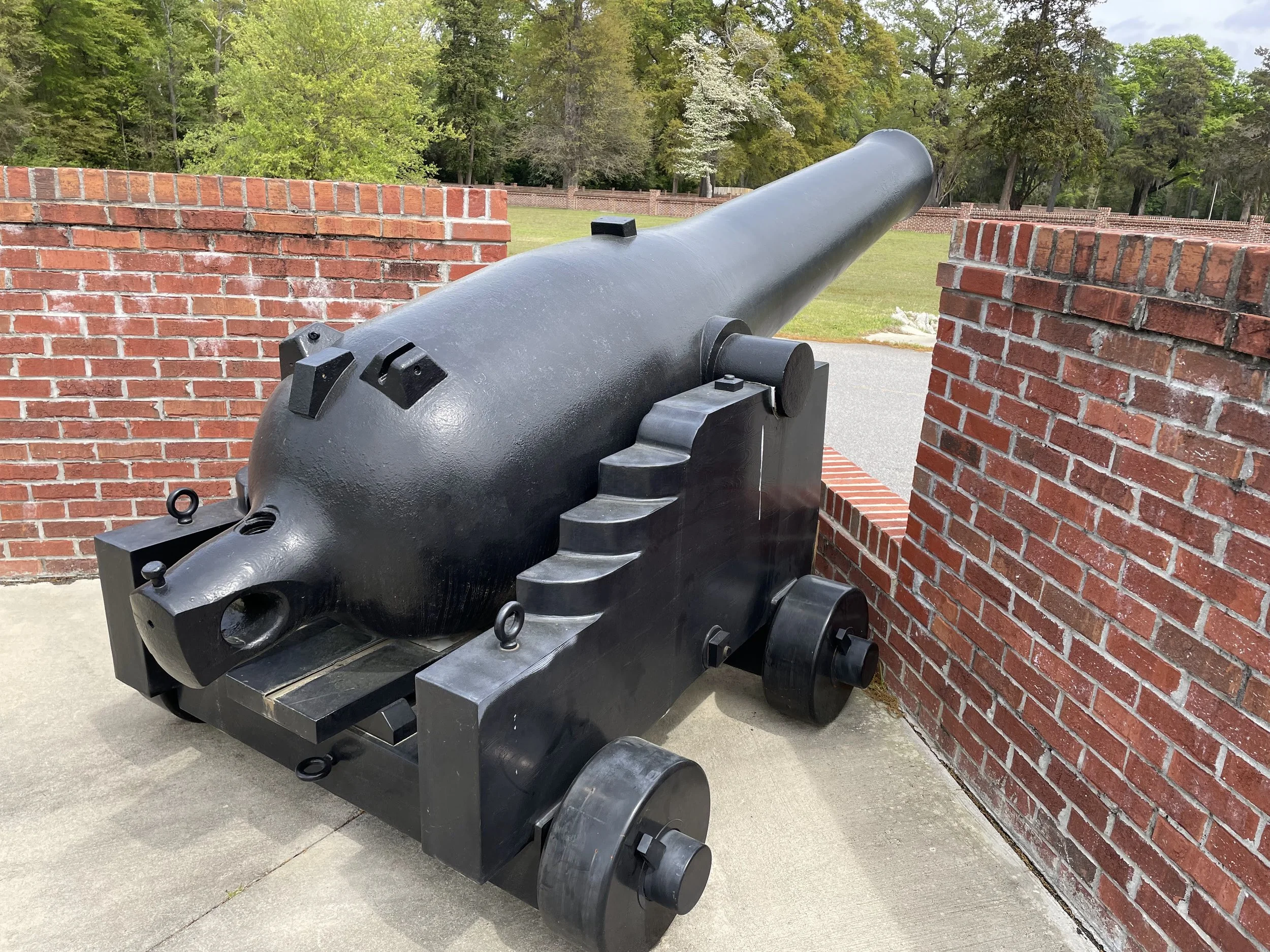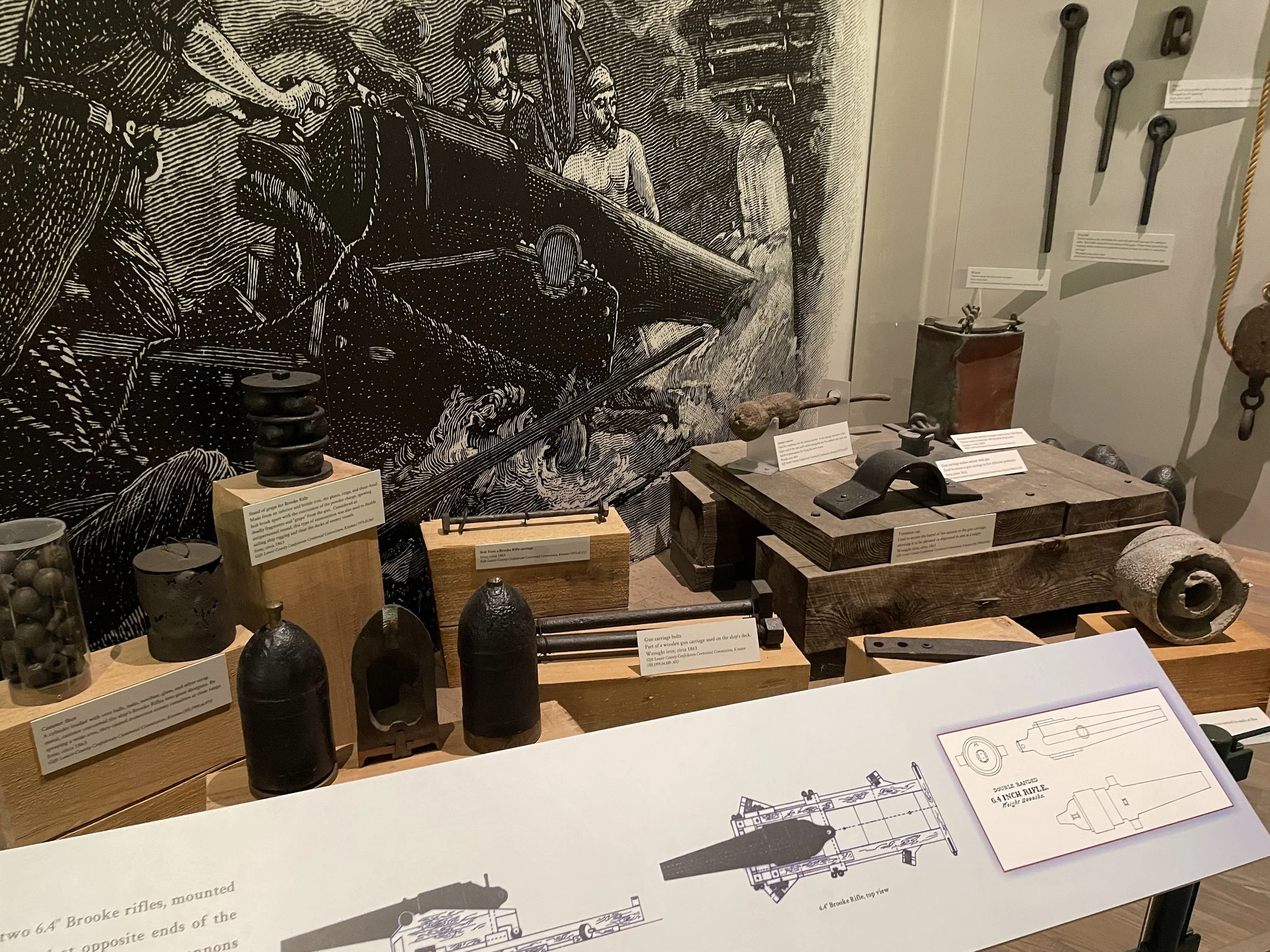The 6.4-Inch Brooke of CSS Albemarle at Norfolk
A 6.4-Inch Brooke Rifle carried aboard CSS Albemarle is displayed at Naval Station Norfolk alongside another 6.4-Inch Brooke from CSS Tennessee
The two Brooke Rifles at Naval Station Norfolk were photographed by friend-of-the-page Vinson Miller. Many, many thanks to him for sharing these photos!
A 6.4-Inch Brooke Rifle carried aboard CSS Albemarle is displayed at Naval Station Norfolk flanking a flagpole with another 6.4-Inch Brooke which was carried aboard CSS Tennessee. It is likely that this Brooke Rifle of the Confederate Navy was aboard CSS Albemarle during the Battle of Plymouth and Battle of Albemarle Sound. It likely sank with CSS Albemarle after US Navy Lieutenant William B. Cushing’s daring spar torpedo boat attack, and it would have been taken as a trophy when Plymouth, North Carolina was recaptured in late 1864.
Plan of CSS Albemarle, Naval History and Heritage Command
6.4-Inch Brooke, Tredegar 1854 and CSS Albemarle
According to the registry in The Big Guns the Albemarle Brooke was cast at Tredegar Foundry in June of 1863 and sent for banding at the Richmond Naval Ordnance Works in October of 1863. It is registry number 50 and Tredegar Foundry Number 1854. It was inspected by Alexander M. DeBree, commander of the Richmond Naval Ordnance Works. As manufactured, it weighed 10,420 pounds. I would expect most of these details could be found as markings on the Brooke, but thick layers of paint currently obscure them.
(The Brooke from CSS Tennessee is registry number 49 and Tredegar Foundry Number 1853.)
CSS Albemarle, a casemate ironclad ram, was built in 1863-1864 at a shipyard established on the Roanoke River at a placed called Edward’s Ferry. Albemarle was armed with two 6.4-Inch Brooke Rifles - each on a pivot mounting allowing it to fire on either broadside or ahead (for the forward gun) or astern (for the aft gun).
Harpers Weekly illustration of USS Southfield sinking while CSS Albemarle drives of USS Miami at Plymouth, April 17th, 1864. Via Naval History and Heritage Command
As USS Southfield sank, CSS Albemarle’s ram remain lodged in the stricken vessel. Only as water began to pour through Albemarle’s gunport was the ship able to back away. Illustration from Abraham Lincoln and the Battles of the Civil War. 1908. pg. 426.
Scale replica of CSS Albemarle on the Roanoke River at Plymouth, North Carolina, July 2024
Replica 6.4-Inch Brooke in front of the Port o’Plymouth Roanoke River Museum, July 2024
CSS Albemarle and the Battle of Plymouth
In April of 1864, Commander James W. Cooke took the newly commissioned CSS Albemarle towards Plymouth, North Carolina. He was engaged by two US Navy gunboats, USS Southfield and USS Miami which were lashed together in an attempt to ensnare the Rebel ram. Albemarle rammed and sank USS Southfield - though the ram lodged in the sinking Southfield and for a time threatened to pull Albemarle down as well. Neither the 9-Inch Dahlgrens nor 100-Pounder Parrot Rifles of the two US Navy gunboats had been able to significantly damage Albemarle’s armor. USS Miami withdrew, and CSS Albemarle began bombarding the US Army positions at Plymouth - contributing to the capture of that town and its considerable supplies (see Official Records - Navies. Ser. 1 Vol. 9. pp 656-658).
USS Sassacus ramming CSS Albemarle during the May 5th, 1864 Battle of Albemarle Sound. Naval History and Heritage Command
US Navy 100-Pounder Parrott Number 38 of USS Sassacus in Reynoldsville, Pennsylvania. Read more about this cannon here: https://www.santee1821.net/preserved-artillery/us-navy-100-pounder-parrott-rifles-of-reynoldsville-pennsylvania
CSS Albemarle and the Battle of Albemarle Sound
On May 5th, 1865 CSS Albemarle ventured further down the Roanoke River to Albemarle Sound near Edenton and engaged a squadron of eight US Navy wooden gunboats in the Battle of Albemarle Sound. During this engagement, USS Sassacus rammed Albemarle, and one of the shots fired by Sassacus struck the muzzle of CSS Albemarle’s aft Brooke - knocking off 20 inches of the Brooke at the muzzle. CSS Albemarle, though not critically damaged by the ramming or the hundreds of 9-Inch and 100-Pounder shot fired at it during the battle, was significantly slowed by its funnel being riddled. Outnumbered, slow, and with his aft gun being partially disabled, Commander Cooke withdrew and took his ship back to Plymouth for repairs (see Official Records - Navies. Ser. 1 Vol. 9. pp 770-771).
Life-size display of the forward section of CSS Albemarle at Plymouth North Carolina at the National Civil War Naval Museum in Columbus, Georgia
Replica 6.4-Inch Brooke mounted in the live-size display of the forward casemate of CSS Albemarle at the National Civil War Naval Museum in Columbus, Georiga
CSS Albemarle after the Battle of Plymouth
Two letters from Commander Cooke to John M. Brooke (Confederate Navy Officer and designer of the Brooke guns) provide an intriguing postscript to CSS Albemarle’s two battles.
In the first letter of May 12th, 1864, Commander Cooke states that he has raised a 9-Inch Dahlgren from the wreck of USS Southfield at Plymouth and that he expects that day to raise the 100-Pounder Parrott Rifle of Southfield. He mentioned the possibility of mounting the 100-Pounder in place of the damaged aft Brooke Rifle aboard CSS Albemarle until a replacement Brooke arrived.
Cooke goes on to praise Brooke’s rifles saying “I think I prefer your gun to all others.” He adds that during the May 5th engagement “we were struck 44 times and twice in one place, but I considered our most serious injury was the shooting away of the chase of the after gun” (Brooke, George M. Ed. Ironclads and Big Guns of the Confederacy: The Journal and Letters of John M. Brooke. pg. 184).
US Navy 9-Inch Dahlgren No. 513 of USS Southfield salvaged by the crew of CSS Albemarle in May of 1864 and sent to Florence, South Carolina to become part of the armament of CSS Pee Dee. Read more about this cannon here: https://www.santee1821.net/preserved-artillery/the-guns-of-css-peedee
In a subsequent letter on May 16th also to Brooke, Cooke writes:
C. S. [RAM] ALBEMARLE,
Plymouth, N. C., May 16, 1864.
SIR: I have succeeded in raising two IX-inch Dahlgren guns and one 100-pounder Parrott gun from the Southfield and hope to succeed in getting the others. The Parrott gun I mounted to-day on the river front, and I wish to know what I shall do with the IX-inch Dahlgrens as I have no projectiles for them. I am very anxious to receive the gun to supply the place of the stern gun. I think that your gun is superior to all others, and had I had two broadside guns I think that I should have succeeded in sinking the whole Yankee fleet. We were struck 44 times, and that, too, at short musket-shot range; they also endeavored to run us down, and when that failed endeavored to surround us with a seine, but fortunately the lines parted in paying out. Have you sent a torpedo?
Very respectfully, your obedient servant,
J. W. COOKE, Commander
(See Official Records - Navies. Ser. 1. Vol. 10. pp. 640-641.)
CSS Albemarle would, of course, be sunk in the daring spar-torpedo boat attack commanded by US Navy Lieutenant William B. Cushing on October 27th, 1864. The ironclad would be raised by the US Navy in 1865 and towed to Norfolk where it was photographed.
CSS Albemarle sunk at Plymouth. Naval History and Heritage Command Photo
CSS Albemarle circa 1865 after it had been salvaged by the US Navy and towed to Norfolk. Two ladies stand on its bow. Naval History and Heritage Command.
Was Tredegar No. 1854 at the Battles of Plymouth and Albemarle Sound?
So, is the 6.4-Inch Brooke Rifle now in front of Fleet Forces Command at Naval Station Norfolk the forward pivot gun of CSS Albemarle which was in action during the Battles of Plymouth and Albemarle Sound? Or is it a replacement sent to CSS Albemarle after the battle? I don’t know for certain.
The only mention of a replacement Brooke being installed that I have thus far read comes from the testimony of three deserters to the commander of USS Miami reported on June 3rd, 1864 (See Official Records - Navies. Ser. 1. Vol. 10. pp. 763-764).
In his letters to Brooke, Cooke seems to imply that Brooke has stated that a replacement will be on its way. Tredegar records reported in Olmstead et al. note three 6.4-Inch Brookes which were being finished in the spring of 1864 - two of which were entered (into service?) in May 4 and May 6th, 1864. These three Brookes are Tredegar numbers 2062, 2064, and 2071.
To me it is curious that only one of CSS Albemarle’s Brookes was preserved as a trophy by the US Navy when the entire batteries of CSS Tennessee and CSS Atlanta were kept. Was the aft gun still the damaged one when the sunken Albemarle was captured? Was it realized by the US Navy that the aft gun was a replacement and the Brooke not saved for that reason? What became of it? Was the aft gun, in fact, replaced with the 100-Pounder Parrott of USS Southfield.
A 1996 article by Michael Phillips posted on the website of Fort Branch states that after the sinking of CSS Albemarle, the Brookes were removed from the sunken ship and added to the defenses of Plymouth until the town was taken again by Union forces later in the year. I’ve not found another reference to Albemarle’s guns being salvaged by the Confederates and captured ashore.
On the whole I think that it is likely that the 6.4-Inch Brooke, Tredegar 1854, which was cast in 1863 is the forward pivot gun of CSS Albemarle. A replacement, if sent at all, was more likely to have been one of the 1864 Brookes. If anyone has further information, I would be glad to hear it.
A 6.4-Inch Brooke Rifle carried aboard CSS Albemarle is displayed at Naval Station Norfolk
A 6.4-Inch Brooke Rifle carried aboard CSS Albemarle is displayed at Naval Station Norfolk
Muzzle of the Albemarle Brooke - Tredegar usually marked their foundry numbers in small characters on the upper muzzle. If this Brooke is marked “1854” here, it has been obscured by layers of paint.
Plate of armor said to be from CSS Albemarle, Portsmouth Naval Shipyard Museum
6.4-Inch Brooke Projectiles and gunnery tools recovered from the wreck of CSS Neuse - CSS Neuse Museum, Kinston, North Carolina
Projectiles and gunnery tools recovered from the wreck of CSS Neuse - CSS Neuse Museum, Kinston, North Carolina








